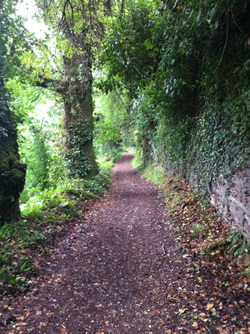 See photo gallery.I took the alternate route (an extra six and a half kilometers) to Sarria this day in order to see the monastery in Samos. I only was able to see the monastery's exterior, however, because, by mid-day, all of the refugios in Samos had filled, and I wound up taking an out-of-town guest house that was located about three kilometers beyond Samos. After I had made the arrangements to stay at the guest house, which was owned by the Val de Samos albergue owner's in-laws, I went to a cafe, had a cafe con leche, and ordered a bocadillo con jamon y queso. I ate a few bites of the sandwich then wrapped it to go and went to a market, where I purchased soap, shampoo, grapes, a litre of Coke, and a Rosado Tempranillo to take to the house. When I arrived at the little house, the owner's wife and sister-in-law, both named Pillar, were in the backyard with the owner's toddler niece. One of the Pillars showed me the guest house and put fresh sheets and blankets on the bed. At first I was so happy to get to sleep without a hundred strangers and without being afraid I was going to roll off of a top bunk, but, after awakening from a terribly realistic nightmare in which the man who owned the house broke in and attacked me, I decided never to go off of the Camino grid again. Since O'Cebreiro, I have been on the stretch of the journey where people pile onto the Camino in order to walk the portion that is required for them to get their Compostela. Therefore, I can expect filled albergues from here on out. ("Oh, joy," says the incapable-of-racing one.) On a positive note, I finally found a bank from which I was able to withdraw euros. Whew!
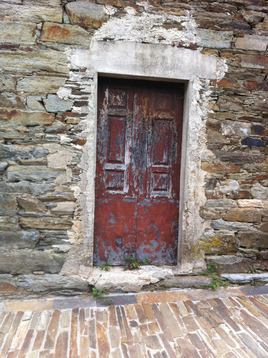 See photo gallery.I got out of the albergue by 8:30. I took my time and enjoyed slowly packing my sack and rolling my sleeping bag. The cafe was open, so I slowly imbibed my cafe-con-leche elixir. Outside the cafe, I chatted with a fortyish steel-gray-haired Spanish male bicyclist who encouraged me to wear a jacket and uttered his excitement about getting to ride the next twelve kilometers all downhill. Before shuffling eleven hundred songs on my IPhone, I talked a bit more with two timid German women and a gray-haired Dutch woman with knotted veins behind her dark-tanned knees. I then set off on my way past the in-town barn with its grumpy belled cows and scampering kittens. Over the next several hours, the French teen scouts and I leap-frogged down the fern-rose-peony-clover-and-ivy-covered mountain. (Okay, so they did most of the leaping.) I skinned my hand when the weight of my backpack caused me to somersault backwards down a hill as I squatted to, er, well, squat. I bought an overpriced braided bracelet from a twelve-year-old girl at her Felicia-style card table as well as purchased sour raspberries, boysenberries, and gooseberries from someone's backyard for one euro; and I, once again, was frightened by a herd of bulls. In Tricastela, I spent too long in the Iglesia, where the priest gave me a special paper in English with remarks specific to particular prayers I had been praying and other thoughts I had been thinking. He had seen me cry as I read it, had clasped my wet-with-holy-water hand when I left, and had said, " Bien. Bien." By the time I came out of the church, all of the Tricastela albergues were completo (full), and I had to walk on another five kilometers to find the next albergue. My foot did pretty well with medication. It was through for the day by Tricastela, but I had to walk on. I took more medication and waited a while for it to kick in before going on to San Cristobo and Fort Lusio. I had planned to take an alternate route from Tricastela to Sarria via Samos the next day to visit the Benedictine monastery in Samos, which is one of the oldest and largest in Spain. However, with the Tricastela inns full, I had to begin the alternate route right then. The road I embarked on was said to be a dangerous stretch of highway. What a surprise awaited me at Fort Lusio-- well worth the extra time and miles. The walk to San Cristobo was comfortable. Those days of 105 degree struggles seemed to be behind me. It was a cool walk with new fauna, a pretty river to the left with tall trees. I walked along the very highway that I had read about in Hape Kerkeling's book, which I had been quite scared to walk along. Maybe it was a difference in traffic flow due to the the time of day that I was traveling versus the time when he had traveled it, or maybe it had been redesigned since he had written his book, but it was not too frightening. No close calls. The scariest part was, not cars traveling dangerously close to me, but having to walk on the other side of a guard rail with a steep drop-off to moving water below. The walk did not take long, and the medicine boost carried me well. About 3:00, I reached San Cristobo, though I was alarmed a bit by the sight of the town. There was one place that said it had rooms, but I did not like the looks of it. I hoped that it was not the Lucio albergue. I continued on, having decided that, if I had to walk another six-point-six kilometers on to Samos, I would do so rather than stay there. I walked about a quarter mile, through beautiful woodlands-- the kind where the trees grow together overhead like leaf-ceilings. To my delight, not far ahead, the path forked with the right prong signed for Samos and the left for the albergue. I took the left. The way narrowed. It passed a field and came to a bridge. The slope up to the bridge was covered in thick straw. I sank to my knees in the damp straw as I stepped onto the bridge. I knew I was getting close and was excited to discover what would be ahead in the bushes. Having gotten across the bridge, I continued to ascend the path, only to find a highway at the top. "A L B E R G U E" in spray-painted letters with a big yellow arrow were splayed on the road. I waited for three groups of bicyclists to whiz by then limped to the other side. A shower, rest, and hopefully food was nearer with each of my off-kiltered steps. As I came around the last curve, I paused to laugh at a chicken pecking a weed on the roadside. I looked up and saw "A-L-B-E-R-G-U-E" spray-painted across the back of a road sign. Turning the corner, I went up this last street, laughing at more chickens. I looked down a narrow way to my right and saw a very small gray haired man in his yard outside his door. He was saying something to me and dramatically pointing. I pulled my ear buds out and cocked my head. He repeated his Galician message and pointed to what I thought was a church. He waved his arms toward it, and I realized that it was the albergue. Looking closer, the edifice looked more like a castle than a church. Actually it had been a fort. Fort Lucio. It was my refuge-- except that the doors were locked. I felt like Dorothy knocking on the door at the Emerald City. The massive door had an opened wooden rectangle in its upper third. I reached through the opening and unlatched the door from its inside. Entering, I found a brown-haired girl with glasses behind a desk. I asked if she had a bed; she nodded. She stamped my Pilgrim's Passport, then wrote my name, country, and passport number in the registry. She collected five euros from me then had me remove my boots and place them on a shelf. She showed me the laundry area and the women's showers and then took me upstairs to the dormitory, which had bunkbeds for twenty-two with nine folks already bedded. Mine was bed ten, a top bunk with half a rail on one side and none on the other. I quickly asked God to keep me from falling off, then asked her if there might be a place I could find food. She asked me if I liked tortilla con potatas. I nodded and she made a phone call on her cell phone, then asked me to meet her downstairs in an hour. I spent the while unpacking, charging my phone, and showering. A bit later, she came by my bed, as I was combing out my hair, and said that she would be ready in fifteen minutes and that she would be my companion. I was unsure what awaited me. I did not know if she had called her mom and was taking me to her home. All I knew was I was hungry and I was grateful for her kindness. Fifteen minutes later, I met her downstairs. She told me her name was Rocia and walked me (quite briskly, I must say) to the very yard of the small, gray-haired man! Rocia and I rounded the corner, as the thin man, his wife, and a teen-aged boy finished setting a tiny table with one chair. On the table were a paper tablecloth, a place setting, a plate with three kinds of meat and cheese, and a fresh green salad with tomatoes, onions, and corn. They greeted me excitedly, then all four, including Rocia, sat me at my table. I clapped my hands and exclaimed, "How beautiful! Thank you so very much!"
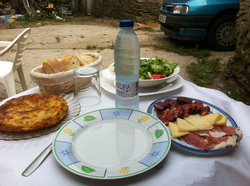 Such royal treatment! It was reminiscent of a magical tea party I had been served by my children when they were tots. To think this fantastic surprise was to be ahead for me, when I was sitting on the side of the road, heavy-hearted, five kilometers back, in inns-filled Tricastela.
Tickled that I was truly blessed, Rocia beamed, waved goodbye to me, and went back to resume her hospitolera duties at the refugio. The gray-haired man's family went on to serve me a tortilla con potatas (similar to a fritatta or omelette with potatoes) with a basket of bread. He asked me if I would like wine. I asked him instead for a glass of water. I wanted the meal to last forever, but the time soon came when I had eaten my last bite of ice cream and the family's chickens had all strutted out of the yard.
I paid the Senora for the family's dinner-gift. I gave her a bit more than I could afford, with my funds drying up and my ATM-withdrawal problem not solved, but I wanted to bless her family as they had blessed me.
What kindness! If only I could take their generous spirits back home. I wish I could run an albergue and cook hearty soups and meals for people on spiritual journeys (as well as for spiritual people on human journeys).
Back at the albergue, the air was electric. The place was full. Another dormitory had opened, and the original nine who had arrived before me were in rare form. The Lindsay Lohan in the bunch was very loud but not as annoying as I had prejudged. She was just very happy and made everyone who came into her sphere happy too. I contentedly drifted to sleep to her joking, laughing, and telling animated stories in rapid-fire Spanish.
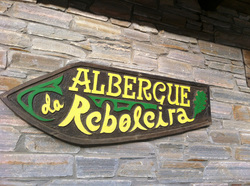 See photo gallery.Dang it. After two good days, this was another bad-pain day. I walked only seven and a half miles, albeit it was mostly all uphill-- but the pain was bad. Moreover, blisters had begun forming again. What the heck? I thought my skin had callused and that I was past that. On a good note, the wrist tendonitis I had developed a couple days ago from flinging on my backpack was less sore (making room for a new pain to crop up). After being frightened by bulls walking toward me (both times they were herded away from me, but they scared me when they noticed me and walked toward me with their pointy horns), I knocked off in Fonfria in the early afternoon. Albergue da Reboleira was a terrific surprise. I would highly recommend it (except that they charged for WIFI). It had a bar/cafe with outside tables; an inside lounging area with couches for reading or playing games; excellent wooden bunk beds with thick, firm clean mattresses; and nicely laundered pillowcases; two individual showers with sinks and toilets each for men and women; a good area for hand- or machine-washing clothes; and a grassy yard for hanging them. I was able to rest, shower, do my laundry, relax in the sun next to a dog-friend, eat a cheese sandwich, and fish a fly out of a glass of Estrella Galicia without feeling awkward or conspicuously solo. And this, outside the refugio alongside a dozen French teen scouts and their scout masters who were goofing around; a couple bicyclists who were studying their route maps; a lady in a pink t-shirt who was talking (in a man voice, I might add) on her cell phone; a girl in a matching pink t-shirt who was fidgeting with her fanny pack; and a middle-aged single gal who was looking like a middle-aged single gal. (You would think that we solo women would hook up, but we do not. There were those who did early on, but, by this point, the rest of us seem to have accepted our uneasy appearances on The Camino and surrendered to the fact that our journeys will be inelegantly alone.) That said, I have become more comfortable on the Camino in general. I have a routine with my showering, laundering, and packing. As soon as I arrive at an albergue, I spread out my sleeping bag, unpack my clothes for the next day, and pull out my mesh laundry bag that already has a small bottle of baby shampoo, a towel, and a rinsed-out soap sheet from the prior day's laundering to use as a facecloth while showering. I hang those items about my shower and put my disrobed clothes right into the mesh bag for laundering after my shower. Having this down so exactly, I am no longer nervous showering with others even when there is no shower curtain. (I had brought a sarong on the trip to use in case there were no shower curtain, but I unloaded it on the first day to lighten my load.) After showering and hopping into my clean clothes, which I sleep in and wear the next day, I take the mesh bag straight to the laundry area, then hand wash and line-dry the clothes. Same routine every afternoon. * * * I was unsure what country the black man who fixed my sandwich came from, but he was very kind and called me "Lady" instead of Señora. Before him, I only had seen two black people on the entirety of the Camino de Santiago: a man who was standing on the Pilgrims' Monument hill with the windmills, soliciting people to stay at his albergue in Puente La Reina (which I should have done), and a man who was walking between Cizur Menor and Puente La Reina with his French wife, while pushing a screaming baby in a carriage up a very rocky trail. I had met a lot of black women in Paris though. All had beautiful dispositions and every one of the women had short-short, cute, curly hair and an adorable personality.
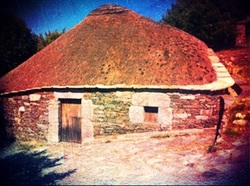 See photo gallery.Having spent the morning sniffing honeysuckle, mint, zinnias, and hydrangea, and hiking past hollyhocks, sunflowers, and lettuce-corn-and-kale gardens, I watched a man in La Faba push his wheelbarrow of potatoes uphill from his garden to the village center and wash them in the town water fountain; I waited while an elderly woman herded her pigs down the road into her yard; and, farther down the path, I ate an orange and cookies in a raspberry patch with the bees before quickly "visiting the bushes" (knowing full well that those traveling the higher road likely could see me if they cared to look). I had a big mountain climb, but crazily I had grown to love the uphill climbs, because my foot did best when it was in a flexed position. I did not use my crippling-crutches (I mean trekking poles), bandages or braces. Instead, I let my body find its natural balance. It was terrific not to hit my nose, forehead, and glasses with five-foot batons every time I swatted at flies. I crossed into the Galicia region early in the afternoon and walked into O'Cebreiro (pronounced Oh-thay-bray-air-oh) shortly thereafter. After showering and handwashing and hanging my laundry, I wandered through O'Cebreiro's little stores in its 15th Century stone buildings that had once been a part of the monastic settlement where Queen Isabella had stayed during her pilgrimage to Santiago in 1486. O'Cebreiro was Celtic in origin and was a very spiritual mixing of Celtic mysticism and Catholicism. Celts believed in "thin places," and I was surprised to discover a thin place between the earth and the spirit realm in O'Cebreiro. Late afternoon, I went inside the stone iglesia (church) to take a look around. I had peeked into the little baptismal chamber and had just noticed the confessionals, when this sense of God's presence leveled me. I found my way to a pew and sat. Tears slowly rolled down my cheeks. (Having no hanky, I kept wiping my drippy-nosed-hand on my sock.) Photo-snapping tourists faded from my periphrea, and I sat basking in the light of God's glory and grace. Every time I started to move, it was as if God would press my head against His shoulder to soothe and comfort me. I do not know how long I sat like that. When I opened my eyes, the church had filled. All but me were standing, and a mass had begun. I understood very little of the mass, but I much enjoyed the rich ceremony, and worshipped the Lord with the others. * * *
After the mass, I had a meal of caldo gallego (a white bean soup, with potatoes, onions and turnip tops, in a pork broth), grilled chicken with potatoes, flan, and cold vino tinto, (having learned the day before that the reason the wine was cold was because it often had cold [sometimes sparkling] water added to it to dilute its strength).
Before bed, I brushed my teeth and zipped the pants back onto my convertible black shorts. It was cold in Galicia, as I was nearing the Atlantic Ocean, and the Galician mountains were the first things the cold winds hit coming off of the ocean.
I went to bed that night thankful for The Second Good Day and for the beautiful "thin place" experience that had insulated me as if I were an infant blanketed in her mother's love.
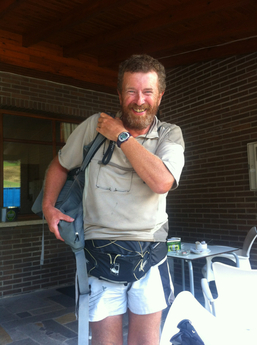 See photo gallery.I was miserable when I was in Astorga. I tried to sleep the whole time, but my foot pain would not let me. Moreover, when I did sleep, I had very disturbing dreams. I also had been unable to withdraw cash from any ATMs, despite my having used numerous supposedly authorized Wells Fargo-Visa locations. But then this day was a turn-around day! I started walking again. I walked about nine miles, and, though I again was unable to walk by nightfall, I, in the meantime, had become more hopeful. Mid-morning, the bus driver dropped me off on the outskirts of Villafranco del Bierzo. I did not know where I was. It was the first time I had been dropped off by a bus where I did not know my way too well. Usually in the center of every town there would be a main cathedral that I could see from the bus, but this time I had seen no cathedral. Eventually, I picked up the Camino trail and began following two peregrinos. It was unusual for me to stay in a pack of people, because of my slow pace, but the boy in front of me had seemed to be limping himself. At one point, I even passed him and began following the other man who was a quarter-mile ahead of me. I followed the man for a couple of miles, then, when I had nearly caught up to him and he had stopped to cross the highway, I hollered out an " Hola." He waited for me, and we walked on together. Henri was a French anesthesiologist. Meeting him at that particular time and spot was quite reassuring to me and was the beginning of what I call The First Good Day. After having been so miserable and in such pain throughout the middle portion of the trip, meeting a French pain specialist then and there was remarkable and renewed my faith in God and in the Camino itself. Furthermore, on the Camino you do not chit-chat. Sure, there is the quick " Hola," " Buen Camino," and " Buen Viaje" in passing, but, when you hold a real conversation, one of the first questions that is always asked is "Why are you walking the Camino?" which immediately takes you to the heart of people's matters. It was no different with Henri. I, of course, spoke no French, but his English was pretty good. He was a married cancer survivor who very much wanted to go to Africa where his daughter practiced medicine. We talked and talked mostly about faith in God and other spiritual matters. The time passed quickly and a few hours later I realized that I hardly had been aware of the pain in my foot. I stopped for the day at an albergue in Portela de Valcarce. Henri had his meal there but then walked on. When we parted ways, I prayed aloud for him, asking God to give him clarity for his future decisions and to abundantly bless his way and marriage. Adding more joy to the day: the albergue was very clean, with a toilet, sink, and shower in a room that I got all to myself. After spending nights with so many in a room and showering and eliminating in stalls with men and women alike, the privacy was a great luxury. Furthermore, while walking today, I kept seeing this sign of a vehicle sliding on the highway under which it said " en heladas." Thinking that helado meant ice cream, every time I saw the sign I would laugh outloud and say, "Ha ha! Slippery in ice cream!" Mostly the day was great because, having bussed through the middle section and having broken up the remainder of the trip over three weeks, the one hundred six miles that I had left to walk now seemed doable.
|






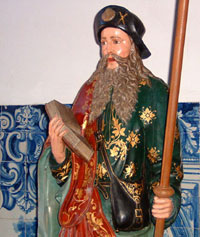
 RSS Feed
RSS Feed